Earlier in April, I visited Rosy-Lane Holsteins up in Wisconsin. The farm is located between Milwaukee and Madison, Wisconsin, north of Chicago about 2 hours. It is about 100 miles north of Rochelle, IL. Wisconsin is called America’s Dairyland because there are so many farms and cows. And you can find more than 200 varieties of cheese! What’s your favorite kind of cheese?
Rosy-Lane is about 2 miles from the Rock River, which also flows south through Rockford, Oregon, Dixon, Sterling, and into the Mississippi River.
Rosy-Lane is owned by: Lloyd and Daphne Holterman and their daughters Lauren and Taylor (college age); Tim Strobel and Jordan Matthews. Tim has been a partner since 1999. Both Tim and Jordan started working for us as teens in high school.
Rosy-Lane is home to 900 Holstein dairy cows. Holsteins are black and white. One hundred baby calves live in our calf barn and some older female calves called heifers live there too.
The farmers grow corn and alfalfa, also, which is made into feed for the cows.
One day, I rode to work at the farm with Daphne on the John Deere gator. I helped enter information about calves into the computer, when they got vaccinations and what they weighed at birth.
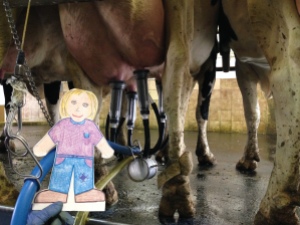
Then I helped milk cows in a room called the milking parlor. Twenty-four cows can be milked at one time – 12 on each side of the parlor! Each cow gives 12 gallons a day; it takes about six minutes for a cow to give all her milk. Inside her udder is tissue like a “sponge” that is gently squeezed in order to get the milk.
From the milking parlor, milk flows in stainless steel pipes through a chiller machine, which drops the temperature from 100 degrees F to about 35 degrees in just 3 seconds. This “flash cooling” keeps the milk quality high so it tastes good! 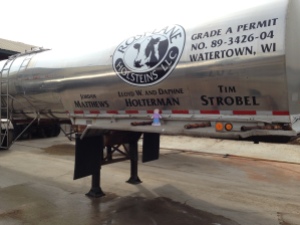 From the chiller, it is pumped onto a shiny semi tanker that holds 6,200 gallons. One semi tanker takes a load every day to the cheese plant about 1 hour away.
From the chiller, it is pumped onto a shiny semi tanker that holds 6,200 gallons. One semi tanker takes a load every day to the cheese plant about 1 hour away.
The cows get fresh feed every morning. I got to smell the feed. It is pungent as it is fermented to preserve quality. It might smelly funny to people, but it sure tastes good to the cows! This pile of feed will be gone in 24 hours and more will be fed the next day. The cows lie down anytime they want in free stalls bedded with lots of clean sand – it’s just like lying on a beach! They also drink water from a big tank anytime they want.
 I saw where the feed is stored before it is mixed for the cows. It is a stored under plastic which is kept in place with heavy tire rings. The pile is 22 feet high! The plastic keeps rain and snow off the feed until it is used. All the corn is harvested for feed during September each year and it lasts until the next harvest.
I saw where the feed is stored before it is mixed for the cows. It is a stored under plastic which is kept in place with heavy tire rings. The pile is 22 feet high! The plastic keeps rain and snow off the feed until it is used. All the corn is harvested for feed during September each year and it lasts until the next harvest.
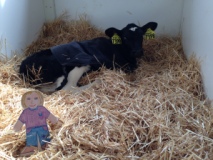 I visited the calf barn and saw this calf. It is just one day old! She is wearing a calf jacket to stay warm for the first 2 or 3 weeks. All the yellow bedding is straw. It is a soft and absorbent bed for her. She has her own pen for the first 8 weeks. Then she moves to a pen with 9 other calves.
I visited the calf barn and saw this calf. It is just one day old! She is wearing a calf jacket to stay warm for the first 2 or 3 weeks. All the yellow bedding is straw. It is a soft and absorbent bed for her. She has her own pen for the first 8 weeks. Then she moves to a pen with 9 other calves. 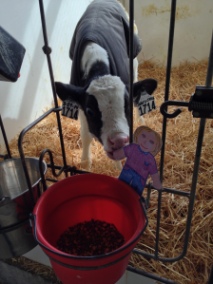 A baby calf gets milk in bottles twice a day at Rosy-Lane. Calves always have water (silver pail) and grain (red pail) to eat. Grain is made up of corn, oats, vitamins & minerals. This calf was so curious and decided to say hello.
A baby calf gets milk in bottles twice a day at Rosy-Lane. Calves always have water (silver pail) and grain (red pail) to eat. Grain is made up of corn, oats, vitamins & minerals. This calf was so curious and decided to say hello.
This is just half of the calf barn. I helped sweep and lime the floor so it is clean – calves thrive in a clean barn with fresh air!
Daphne says her favorite part of farming is watching babies being born, when they take their first breath.
You can follow Rosy-Lane Holsteins on Facebook and follow the adventures of their cows!
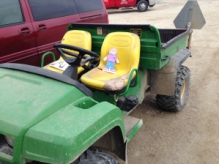
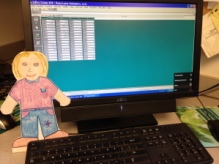
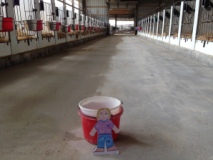




Leave a Reply